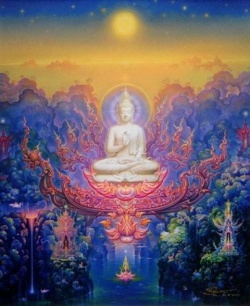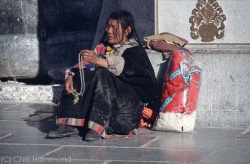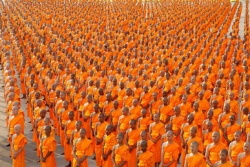Buddhist Prophecies
E.M. opens a discussion of what could be called a millenarian strain within Buddhism. This is an interesting line of inquiry. There are scriptural supports for an historical/prophetic narrative (see especially the two suttas of the Digha Nikaya, the Agganna Sutta and the Cakkavatti Sutta) The prophetic narrative has at least four separate but overlapping strains;
The Cyclic Arising and Falling of the World - Everything is impermanent, including this earth and world-system. It arose at a certain moment in the past, evolves through various stages, and will at least come to an end; in this cycle through fire. The details of this cosmological narrative make an interesting study, but a few things should be noted which differentiate it from the narratives of the theistic religions. Firstly, it is a cycle. There is no ultimate beginning or ending. There is no final apocalyptic climax, just a clearing of the decks for a new world-system much like the old one. Secondly, it is not seen as some grand divine plan but just the unfolding of natural law; there is no real plot in samsara. We are not developing to some final triumph of good over evil. Thirdly, the end even of this world-system is not traditionally seen as imminent, but is safely put off thousands of years in the future. Fourthly, the end is not something any Buddhists have ever desired or sought to manifest.
The Coming Buddha One coming event that many Buddhists do look forward to is the arising of Metteya (or Maitreya) Buddha, the next or coming Buddha. In the Theravada reckoning he will be the last Buddha of this world-system, but still a few thousand years away, and a few thousand more before the end. In some times and places, the concept of the coming Buddha has become a significant aspect of Buddhist practise and belief. Some modern Buddhists, especially in Sri Lanka, believe that we are now in an age of such decline of the Dhamma that it is no longer possible to attain the path-and-fruit so that the best we can aspire to is rebirth in the time of Metteya. This idea may have some resemblance to the Messiahs and Mahdis of the theists but again we should note the differences; Metteya is not seen as the final culmination of history; he is one Buddha in an infinite series. Nor has his expected appearance ever appeared imminent or caused millenarian movements as we have seen time and again in [[Wikipedia:Christianity|Christianity]] and Islam. Judaism has been a bit more restrained in this regard, but there is the strange case of Sabbatai Levi.
Admittedly, there are at least three or four pretenders currently claiming to be Maitreya, but that's really a New Age thing and none of them are taken seriously by any Buddhists.
As a last note, I recently heard a joke poking gentle fun at those Buddhists who put all their aspirations in the future Buddha. Q. What is the first question people will ask Metteya when he comes? A.- The next Buddha, what's his name?
The Wheel-Turning Monarch Most of you will probably be familiar with the story that the infant Siddhattha was destined to be either a Buddha or a Wheel-Turning Monarch. There is also the Cakkavatti sutta referenced above which details the myth of the Wheel-Turner. He is a great and wise world-ruler who arises at long intervals to usher in an age of righteousness. He conquers the whole world without shedding blood and has a number of magical signs associated with him; most notably, the appearance of an eight-spoked wheel in the sky over his palace. This wheel travels with him and awes rival kings to submit to his authority.
The scholar S.J. Tambiah has made a study of how this mythology has under lain the monarchies of S.E. Asia, both as ideal and as rationale. (See World Conqueror and World Renouncer) This concept was also critical for understanding the Ashokan Empire.
The Age of Decline Finally, one aspect of Buddhist prophecy very central to all these narratives is that this current time is an age of slow but inexorable decline. At the time of the arising of a Buddha, there is a brief Golden Age when many beings with excellent karma are reborn at once. Many of these attain Nibbana in the first generation and are removed from the world. Those who are almost as refined may take a few more lifetimes, but by the time we get to a period long after the Buddha, all that are left are sorry specimens like ourselves. Lifespans, morality, wisdom, all decline steadily until everything bottoms out in a dark period when humans will revert to an animal existence with a lifespan of ten years. According to one traditional reckoning we are about half-way down the slope already.
This myth is in direct contrast to the western myth of progress. This isn't as popular, perhaps, as it was in the eighteenth and nineteenth centuries, but still has its adherents. Personally, I don't find the myth of progress very convincing. The twentieth was the worst century ever; at least the first half. The twenty-first is sure off to a rough start also.
I know someone will object that lifetimes are actually getting longer, but are they? You sometimes hear that people in pre-modern times had a life expectancy of thirty or forty. This leads many writers to assume that old people were very rare, but this isn't supported from contemporary accounts. What seems to have been the reality is that infant mortality was very high; highest in the early industrial period actually. If you factor out infant deaths, people two or three hundred years ago probably lived at least as long as we do.
We really have no way of accurately knowing what lifespans were like in ancient times. There are many passing references in the Pali Canon which would lead one to believe that one hundred was considered the normal human life expectancy at the time. Certainly, in morality and wisdom, we are no better than the ancients, and probably a damn sight worse


